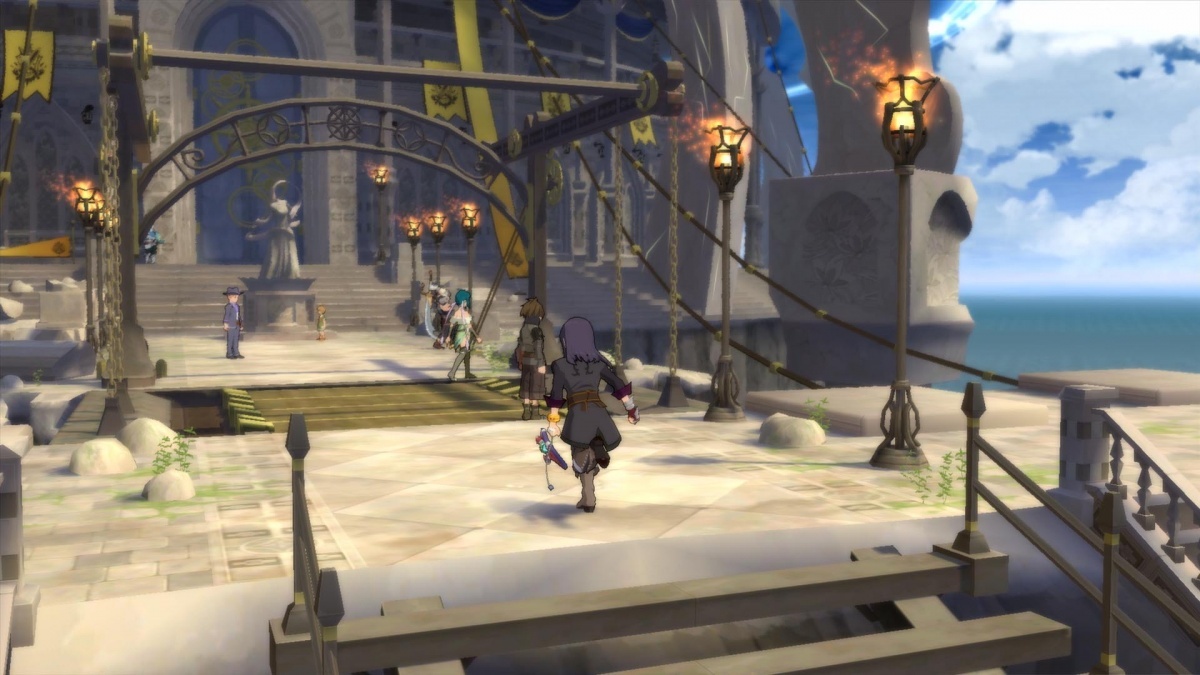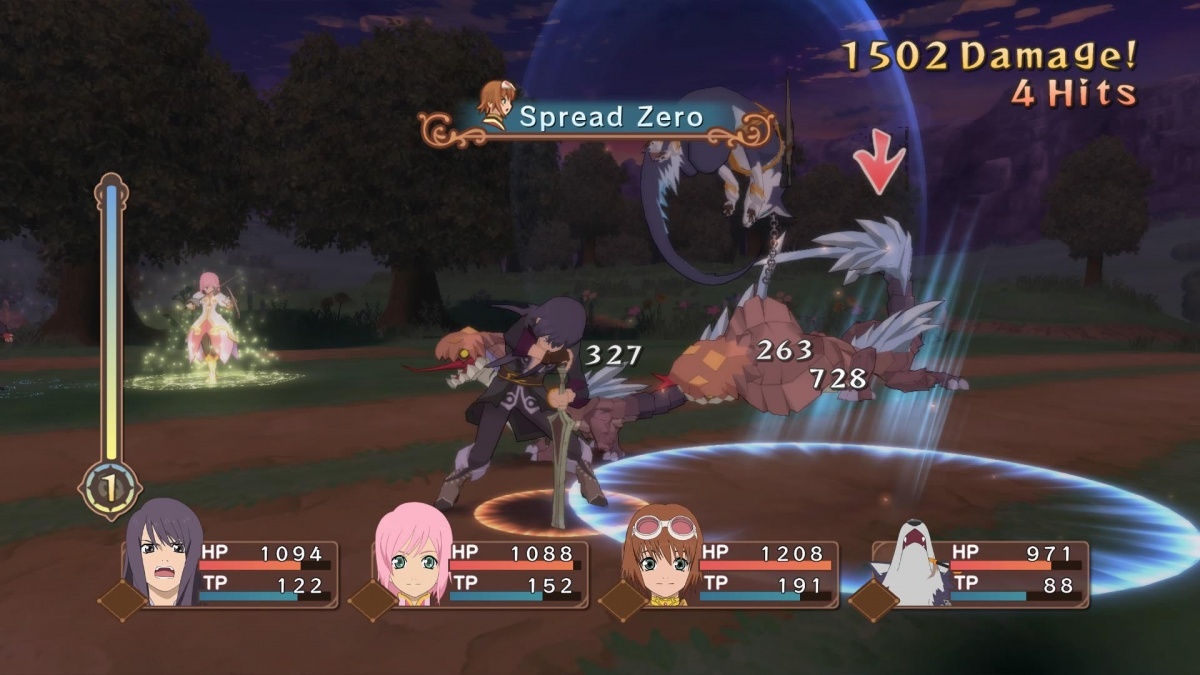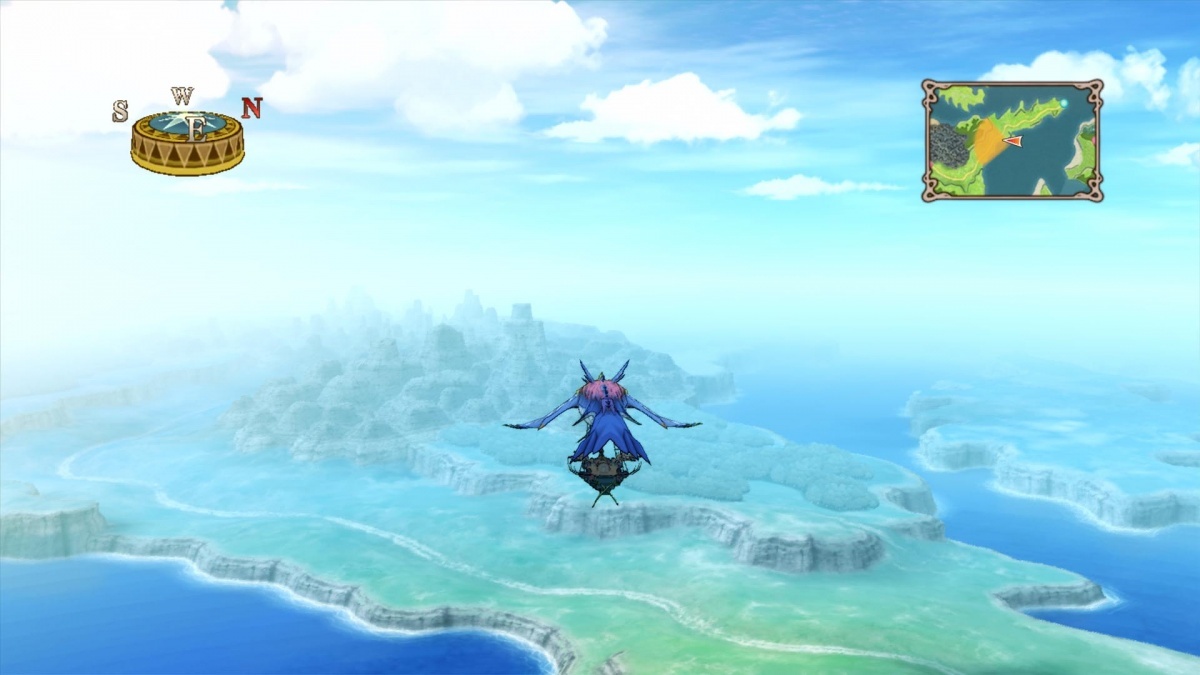Tales of Vesperia: Definitive Edition (PlayStation 4) Review
By Renan Fontes  09.01.2019
09.01.2019

A little over one decade ago, Tales of Vesperia released exclusively on the Xbox 360 as one of the console's early life JRPGs. As a result of the genre's popularity in Japan, but the relative unpopularity of the Xbox 360, Bandai Namco saw fit to rerelease the latest "Tales of" with a host of additional content on the PlayStation 3. Unfortunately, said revision never saw store shelves outside of Japan, depriving fans of the superior version of what many considered to be the strongest entry in the franchise. Seemingly out of nowhere, Bandai Namco not only announced yet another rerelease, but one that would feature a worldwide release. After ten years, western audiences are finally getting their chance to dig into the definitive version of one of the greatest RPGs ever made, this time on PlayStation 4.
In theory, Tales of Vesperia is not particularly unique in the grand scheme of its franchise. Not only are all the story's major themes simply core parts of any given entry in the series - racial unity and the concept of justice - and very few characters carry their arcs all the way through to the narrative's final moments, whereas other entries typically feature consistent development for most party members from start to finish. What separates the franchise's tenth mainline entry from its predecessors is ultimately how it approaches its themes and cast. The subject of race, this time codified by the dichotomy between humans and the beast-like Entelexeia, is not particularly unique in comparison to previous entries, but how the struggle between the two races develops is handled with far more tact and nuance than the series had previously seen, placing emphasis on why the divide is present rather than just how the divide came to be.
As a result, where earlier instalments would wave away racism with a war or prejudiced act before breaking down why racism is indeed wrong or bad, Vesperia's plot takes quite a bit of time in explaining the societal happenings that lead to the events of the story proper, and the ultimate fallout that would come in such a large speciesism-born disconnect between the planet's two major races. In regards to justice, the theme is exemplified by the narrative's two most prominent leads: Yuri and Flynn. Where Yuri has chosen to take justice into his own hands, actively breaking the law in order to better the world, Flynn opts to fix the system from within, joining the Imperial Knights in order to work his way to the top so that he may instate major social and political reform. A lesser story would see these two characters and choose to glorify one over the other, but this is not a lesser story by any means.

Yuri and Flynn are two of the most well realized foils in the medium, exemplifying their ideologies, faults and all. Where Yuri can break the law how he pleases in order to force change, he must also live on the run, risking desensitizing himself to the horrors the system he wants to change instil. Where Flynn can use the law to his advantage and influence the political world around him, he risks getting caught in the bureaucracy of politics, potentially locking him in a position where he cannot afford to push for radical change. Both Yuri and Flynn embody valid attempts at social reform without sugar-coating the situation both characters are in.
Of all the playable characters, Yuri and Flynn are the two standouts as they are the only two characters who actively develop through to the very last arc. As is the case with most entries in the series, Tales of Vesperia features three major story arcs, each building upon the last. The first begins with Yuri trying to catch a thief who disrupted the way of his life in his lower class home; the second heavily revolves around the social reform both Yuri and Flynn are pushing for; and the last plays with the ever traditional "save the world" trope. Although the plot may not flow seamlessly from arc to arc on paper, the experience itself is seamless. What begins as a personal quest to take back a stolen Blastia ends with Yuri facing off in an apocalyptic showdown to save mankind, and it all plays out naturally. A large reason why the story can escalate so jarringly yet so genuinely is thanks to the pacing. Pacing that would not work nearly as well if each arc placed each playable character in a major position.
As previously mentioned, not every character's arc plays out to the very end. In fact, Yuri, Flynn, Karol, and Patty are the only characters to receive major development in the final part of the story. Estelle, Rita, Judith, and Raven are all more or less fully developed by the second section, whereas Repede mainly sticks to the sidelines, as he is a dog, and the silent kind at that. This isn't a flaw by any means, though. Rather, it allows each member of the cast to develop naturally without needing to elongate the plot or drag out character arcs. Rita barely develops after the first part, and Raven's narrative importance plummets as soon as the final one begins, but any more major development for either character could serve to undermine what development they did see. More importantly, it isn't as if the script forgets developed characters exist. Party members actively participate in dialogue either through the story's main beats or via 'Skits.'

Skits have been a staple of the series since Tales of Destiny. A means of fleshing out characters without breaking the flow of gameplay or the plot, Skits are optional scenes that can be triggered at just about any given time. Some Skits require prerequisites, whereas others appear after plot relevant moments, or major boss fights. Either way, these work to help flesh out the inter-cast chemistry, and even offer minor nuggets of development. These also serve as a crucial world-building tool. While every "Tales of" does a fine job with world-building, Vesperia's is one of the stronger all around, especially in regards to how it approaches societable interactivity. Although Terca Lumireis has the standard genre Empire at the front and centre of politics, the world is also divided by Guilds; non-government factions that live outside the laws of the Empire. With such a diverse cast of characters, Skits serve as a means of meaningfully commenting on the relation between the Empire, Guilds, and those caught in between.
What really drives home the scope of the plot is the script. Outside of the occasional typos that Bandai Namco has become unfortunately known for in recent years, the writing and localisation are as strong as ever. From a merely mechanical perspective, no two characters speak alike, but rarely do they devolve into speech patterns or quirks that tend to plague the JRPG genre. Brave Vesperia is made up of actual people who speak like humans, interact like friends, and share a sensible goal that, while of course laced with the "friendship is power" motif stereotypical for the series, never strays from an understandably mature perspective, something that really helps the narrative shine so bright. There is a delicacy to how the story moves from beat to beat, how each member of the cast develops, and how themes are expressed. Yuri is the rare character who actively kills other people, but it is neither glorified nor overtly vilified. It is something he feels he must do outside the realm of the law, but it is likewise a trend the story comments on in order to push Yuri's growth as a protagonist.
Part of what makes the last arc seem like a natural fit for a story inherently about the law and social reform is how it builds off the subject of race, and twists the very foundation of Terca Lumireis, the Blastia, into a way of commenting on the dangers of excess. In some respects, this last section takes on a very "green" message, clearly basing itself off the threat of climate change, but it never strays from the heart of the plot. Even in an apocalyptic scenario, politics and the law play a crucial role. Tales of Vesperia does not stray away from that and instead embraces it for a more cohesive narrative. Where the story is absolutely a step up from previous installments, however, it's the game design where Tales of Vesperia solidifies itself as one of the RPG greats. Using a modified version of Tales of the Abyss' Flex Range Battle System, characters can freely run on a 3D plane before returning to a condensed 2D line in order to attack. Where Abyss locked actions to the 2D Plane, the Evolved Flex Range Battle System allows each characters to chain out of the 3D field with a single attack before returning to the 2D battle system.

Although most action RPGs encourage a more aggressive play style, the Evolved Flex Range Battle System heavily incentivizes a more strategic approach to battle. As action takes place on a 3D arena, it can be easy to lose view of enemies in the background, potentially opening up the party to getting comboed. While every member comes with its own set of preset tactics, the strategy menu allows for full in-battle customization. Given Estelle's role as the party's dedicated healer, it's only fitting to strategically handle her so she keeps her distance away from bosses and enemies. Judith's acrobatic Artes allow her to attack quite vigorously in the air, but doing so can hinder combo chaining. As a result, it might be beneficial to toggle Judith so she attacks different enemies from that of the player character. Strategies can even be edited mid-battle, a welcome fixture that allows for on the fly decision making that ends up especially beneficial on higher difficulties.
Where the base game featured seven playable characters, the Definitive Version adds two more, bringing the full party count up to nine. Each character has their own distinct play style with unique Artes, "Tales of-like" special attacks that can be used in battle to chain combos together. Although a good chunk of the experience is designed with the idea that most first playthroughs will heavily feature Yuri in the lead role, there is no real disadvantage to experimenting with party layout or the player character. Yuri's play style is fast and heavy hitting without dominating everything in his past. His later Artes can be used to pull off more intricate combos, keeping enemies locked in a loop for longer, but his greatest strength comes from the speed at which he can initiate said combos. Estelle is slower than Yuri and doesn't hit as hard, but her swordplay does make basic chaining doable along with her healing Artes ensuring she'll always be able to play a critical role in battle even if she can't attack.
Of all the characters, Repede is perhaps the fastest, ensuring constant combos with his ability to steal from enemies as a bonus to make up for his lack of overwhelming offense. Rita plays the role of the traditional mage, hitting from long range and hitting quite hard. Her better Artes will always require a bit of time to charge, but creating distance between Rita and the enemy will always net a positive outcome. The last two of the original roster, Raven and Judith, are arguably the most complex characters to play as. If nothing else, they are clearly designed with veterans capable of chaining combos in mind. Raven primarily fights from long range, but he is capable of being a proper front line attacker with the right Artes.

Judith herself is clearly designed around launching enemies into the air and chaining them back down. With the right Arte set up, Judith is perhaps the best character to pull off flashier combos. In regards to Artes, it's worth mentioning that the controlled character can initially have four set at any given time. X, X + Up, X + Down, and X + Side all trigger the equipped Arte at the expense of TP. Later on, an optional item can be synthesized via the crafting system to allow the right analog stick to be used as a second set of Artes: Right Stick Left, Right Stick Right, Right Stick Up, and Right Stick Left pave the way for more involved comboing.
In addition to Artes, each party member can learn Skills off of equipped weapons. Should a weapon have a set of Skills attached, each battle will gradually award LP that will then allow characters to equip said Skills independent of the weapon. Early on, this is merely a means of earning some quick buffs for any given character, but later weapons to reward more intricate Skills. By mid-game, players are certain to find weapons that will allow characters to chain different types of Artes together, deeply reworking the combo system and upping what they are capable of in battle. Skills serve as an excellent means of both progression and customization - and through them the battle system can evolve at the will of the player. With the right set up, Yuri can use an Arcane Arte, chain it immediately into a Base Arte, and then close his combo with another Arcane Arte. This is especially useful given the nature of Fatal Strikes, a quick time event-esque moment in which characters can damage enemies immensely with R2 after wearing their defences down with the proper Artes.
Learned Skills can't just be equipped all at once, however. Each Skill has a set cost and party members won't necessarily have the right amount of points to equip haphazardly. Skills need to be chosen meaningfully and around the role each character will be playing in battle. It doesn't make much sense for Estelle to have offense based Skills equipped if the selected strats will keep her in the background healing other characters. Although it's not particularly difficult to find good weapons with Skills thanks to some generous dungeon loot, synthesizing makes for the best and most affordable way to consistently have strong equipment. Instead of spending Gald on new weapons, Yuri's party can use found materials from battles to craft weapons, items, and armour at any given shop. Synthesis recipes can typically be learned simply by talking to NPCs near the shop, but higher tiered equipment will take a bit of work to get ready thanks to the necessary materials.

Good game design doesn't just apply to combat and the inner working of the battle system, however. Although Tales of Vesperia very much does shine in that regard, it is bolstered by excellent level design that applies just as much to dungeons as it does to the overworld. Terca Lumireis is nearly devoid of meaningless space, with each continent featuring identifiable landmarks and locations that strike a balance in distance where nothing is too close or too far away from one another. The dungeons are not the best overall in the franchise, but they are the most consistent in quality with no negative standouts. This isn't to say some of the dungeons don't excel either, though. Baction, Zaude, and Tarqaron, are three of the strongest dungeons in the entire franchise offering intricate puzzles, memorable boss fights, and engaging layouts. While not every dungeon can offer such a spread of content, each features a well realized aesthetic.
Graphically, the art style has aged wonderfully. Even without a resolution upscale, Vesperia would have looked fantastic. Vibrant colours, soft edges, and just the right amount of realism ensure that every facet of the world looks downright beautiful. Even modern entries in the series don't quite rival the vibrancy of Terca Lumireis. Halure, Mt. Temza, and the Erealumen Crystallands all exemplify the art style at its very best, creating a sense of immersion built entirely off of aesthetic. Although the base game is absolutely worth playing in its own right, the Definitive Edition does bring quite an extreme degree of new content. Most notably, the inclusion of Flynn as a full party member and the introduction of Patty, a young pirate girl who believes herself to be the granddaughter of "Tales of" mainstay Aifread. In so far as other additions go, new areas have been added to the overworld along with new dungeons and plenty of side content to wade through.
Flynn himself is an excellent addition to the party as, even in the original version, he served as Yuri's foil and deuteragonist. While his exclusion from the party was narratively justified, it was still a bit jarring to head into finale without a character that very much helped shape the story's core themes. As a result, several moments in the story are edited to now feature Flynn as a playable character, joining more than just his once in the original release before permanently joining the party for the final dungeon. As a playable character, Flynn is more or less a stronger Estelle right down to having his own set of healing Artes. This doesn't mean he doesn't come with his own unique set of abilities to differentiate him from his pink haired counterpart. While he isn't as fast as Yuri, he can chain combos just as well if not better than his rival. Humorously, Flynn plays much how a traditional "Tales of" protagonist would be expected to play. As a late game addition, Flynn makes for a welcome change of pace at the eleventh hour.

Patty is more of a mixed bag than Flynn. As a player character, she's downright incredibly and clearly designed with veterans in mind. Her chaotically frantic play style keeps her in the action almost non-stop. Her hits are relentless and her combo potential is through the roof. In terms of usability, Patty may very well be one of the better characters in the entire franchise, offering an incredibly degree of high level play. Unfortunately, her inclusion in the story isn't as seamless as Flynn's. Although Flynn wasn't initially part of the original party, he had a constant presence in the plot through Yuri. By the last dungeon, even if Flynn wasn't in the party, his role could still be felt both narratively and thematically. Such circumstances allow him to mesh easily into the main cast. Patty, however, is blatantly a new addition who never quite feels properly in place.
From her dialogue to her design to her demeanour, Patty is the weak link in the cast. Where the other major characters communicate to one another like actual people, Patty's entire speech pattern is dominated by nautical puns, a sour spot in an otherwise incredible script. Whether this is due to shoddy localisation or not, her very role in the story is not nearly as meaningful as the other character, primarily due to the fact that, of all the blatantly supporting players, she is the only one save for Karol who develops over the course of all three arcs.
Patty is the exception to Tales of Vesperia tightly crafted set of rules, but she actually isn't quite so offensively bad. She is certainly a step down from the other major players narratively, but she would fit fine as a decent enough background character in any other entry. Her greatest crime is that she is a mediocre character in an RPG that's all around fantastic. Even then, though, her plot goes by fast enough and the conclusion to her arc is surprisingly nuanced and well done for how lacklustre the build-up can be. Either way, when it comes down to it, Patty's biggest contribution is in her stellar gameplay and nothing can deprive her of that accomplishment. Ultimately, the additions brought with the Definitive Edition takes an already fantastic RPG and makes it even better. Tales of Vesperia is a key example of how a game can thrive thanks to balance. Excellent gameplay, excellent story, and excellent dungeon design all blend into a perfect storm that Brave Vesperia is in the centre of. Tales of Vesperia is a must play for anyone who loves "Tales of," RPGs, or just videogames in general.

Cubed3 Rating
Exceptional - Gold Award

Boasting the best script, best overworld, and best pacing the series has ever seen, Tales of Vesperia stands out as the single strongest entry in the franchise. Though later entries do feature stronger casts and gameplay mechanics, this is not lacking in either department. The members of Brave Vesperia all share an excellent amount of chemistry with one another, and the combat, while comparatively simple, actually thrives in how easy to pick up but difficult to master it can be. While not every addition exclusive to the Definitive Edition exactly benefits the narrative - a shame considering how thematically cohesive and airtight the overall story is - each gameplay addition is ultimately for the better, from the two new party members all the way to the new dungeons. Tales of Vesperia is a high point not only for its franchise, but for its genre.

![]() 9/10
9/10
![]() 0
(0 Votes)
0
(0 Votes)
 Out now
Out now  Out now
Out now  Out now
Out now  Out now
Out now Comments
Comments are currently disabled

 Sign In
Sign In Game Details
Game Details Subscribe to this topic
Subscribe to this topic Features
Features






 Top
Top

